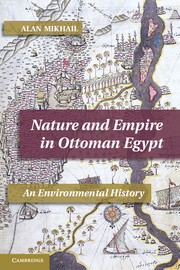Book contents
- Frontmatter
- Contents
- Maps
- Figures
- Tables
- Note on Transliteration and Dates
- Abbreviations
- Acknowledgments
- Map 1 Egypt and the Ottoman Empire
- Map 2 Lower Egypt (Nile Delta)
- Map 3 Middle Egypt
- Map 4 Upper Egypt
- Map 5 Cairo and Surroundings, 1801
- Introduction: Empire by Nature
- 1 Watering the Earth
- 2 The Food Chain
- 3 The Framework of Empire
- 4 In Working Order
- 5 From Nature to Disease
- 6 Another Nile
- Conclusion: The Imagination and Reality of Public Works
- Appendix: Citations for Cases Included in Tables 2.1–2.4
- Bibliography
- Index
- Titles in the series
Conclusion: The Imagination and Reality of Public Works
Published online by Cambridge University Press: 03 May 2011
- Frontmatter
- Contents
- Maps
- Figures
- Tables
- Note on Transliteration and Dates
- Abbreviations
- Acknowledgments
- Map 1 Egypt and the Ottoman Empire
- Map 2 Lower Egypt (Nile Delta)
- Map 3 Middle Egypt
- Map 4 Upper Egypt
- Map 5 Cairo and Surroundings, 1801
- Introduction: Empire by Nature
- 1 Watering the Earth
- 2 The Food Chain
- 3 The Framework of Empire
- 4 In Working Order
- 5 From Nature to Disease
- 6 Another Nile
- Conclusion: The Imagination and Reality of Public Works
- Appendix: Citations for Cases Included in Tables 2.1–2.4
- Bibliography
- Index
- Titles in the series
Summary
After the completion of the Maḥmūdiyya's reconstruction in 1819, a stone tablet was placed at the canal's mouth and another at its end in Alexandria to commemorate the project. The tablet at the canal's start claimed that “the glories of the Sultan had brought life to dead lands” near the waterway and had “reanimated” them through a return to cultivation. The tablet at the end of the canal continued this theme by asserting that the Ottoman dynasty had caused the Nile “to flow once more.” These triumphalist declarations by the Ottoman bureaucracy that described the Empire as the source of agriculture's rebirth and of the return of water to Egypt contributed to the notion that an irrigation work like the Maḥmūdiyya could serve as the single necessary magic solution to the very complex ecological problems of water scarcity, siltation, seepage, and salinization. The idea of the renewal of land and water through public works in Egypt began with the Maḥmūdiyya and would prove a fundamental conceptual cornerstone of similar projects throughout the nineteenth and twentieth centuries.
Renewal, rebirth, and revitalization of course all mark both an end and a beginning. In the case of the Maḥmūdiyya, its reconstruction represented the end of an early modern system of Ottoman imperial natural resource management that served to move food, wood, and other items around the entirety of the Empire.
- Type
- Chapter
- Information
- Nature and Empire in Ottoman EgyptAn Environmental History, pp. 291 - 296Publisher: Cambridge University PressPrint publication year: 2011



